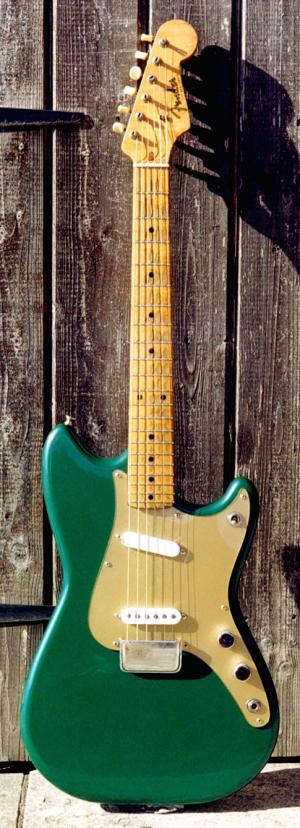
By the mid-1950's the major musical instrument manufacturers were acknowledging that rock'n'roll was, indeed, here to stay and providing a huge market for electric guitars. Aware that this new craze was patronised mainly by teenagers with little in the way of spending cash, budget "entry level" electrics were soon made available for beginners and students. Gibson offered their Les Paul Juniors and Specials and the arch-top ES-140; Gretsch followed suit with the dinky Rambler; Rickenbacker had their Combo 400 range of solids, and in 1956 Fender launched their Duo-Sonic and Musicmaster models.
Built to the same quality standards as their up-market Strats and Teles, these guitars featured a smaller body with no "off-set" waist or contours, and a one-piece maple neck with shorter scale length of 22½". The bodies of both guitars were routed for two Stratocaster pickups and a selector switch, though the cheaper Musicmaster had just one pickup at the neck position, and no switch. The Duo-Sonic featured a wiring circuit unique to Fender at the time: the bridge pickup was positioned back-to-front, and with the switch centred and both units active the current followed a figure-of-eight pattern, effectively creating one big, fluffy-assed humbucker! This principle was the basis for Gibson's new pickups that appeared the following year, which would revolutionise guitar electronics henceforth.
Corners were cut to keep within budget. The Kluson tuners were supplied with plastic buttons, there was no tremolo system offered and the simple bridge consisted of three adjustable saddles carrying two strings each. The pickups had plain white plastic covers, the electronics mounted on an aluminium gold-anodised escutcheon. The two-piece alder bodies were painted in Desert Sand, though not lacquered to quite the same high gloss as their expensive sisters. The guitars came complete with a small rectangular vinyl-covered hard case.
By late 1959, rosewood fingerboards became standard and the aluminium scratch-plate was replaced by a white vinyl substitute with four extra screws. The Desert Sand finish was phased out and replaced with a disgusting-looking maroon-to-sand "Sienna" sunburst that did the guitars no favours at all, though custom-colour options became available from 1960 onwards. The pickup covers were also changed, from white to dark brown.
As can be seen, this example bears few of its original factory specifications. Purchased in a very shabby condition as a "fixer-upper", its basic component parts of neck, tuners, body, bridge, neck pickup and switch are intact. The lovely Sherwood Green metallic colour is its fourth re-finish, this one done by bespoke guitar restorer Clive Brown of Ripon, Yorkshire. The pick-guard is actually clear Lucite sprayed gold underneath, and is the work of the super-talented Dennis Fano (qv), of Bloomfield NJ, U.S.A. Anyone doubting Dennis' genius should take a close look at this, hand-tooled especially for this guitar from a dodgy template I mailed to him. The bridge pickup is a new unit from Seymour Duncan, the APST-1 Twang Banger, a Telecaster lead replacement designed to fit a Stratocaster. Only the middle two pole-pieces are raised, making it ideal for mounting back-to-front, and it packs a huge punch whilst still retaining that visceral twang that Tele-heads know and love. My only reservation is that the exposed magnets spoil the look of the guitar, but it's a small concession for what is a significant improvement in sound and performance.
The prices of 'fifties Fenders having spiralled beyond the reach of most of us, the Duos and Musicmasters represent some of the last real bargains in vintage American guitars today. The short scale notwithstanding, they nonetheless deliver the classic early Fender sound that mysteriously draws tens of thousands of dollars from collectors and investors world-wide. These student models can still be had for well under a grand, so if you can live without bells, whistles and a whammy-bar I urge you to seek one out quickly, before the dealers get them all...